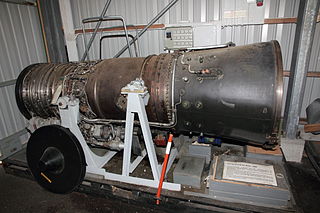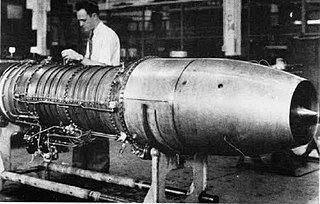Related Research Articles

The Pratt & Whitney J57 is an axial-flow turbojet engine developed by Pratt & Whitney in the early 1950s. The J57 was the first 10,000 lbf (45 kN) thrust class engine in the United States. The J57/JT3C was developed into the J52 turbojet, the J75/JT4A turbojet, the JT3D/TF33 turbofan, and the XT57 turboprop. The J57 and JT3C saw extensive use on fighter jets, jetliners, and bombers for many decades.

The General Electric J85 is a small single-shaft turbojet engine. Military versions produce up to 2,950 lbf (13.1 kN) of thrust dry; afterburning variants can reach up to 5,000 lbf (22 kN). The engine, depending upon additional equipment and specific model, weighs from 300 to 500 pounds. It is one of GE's most successful and longest in service military jet engines, with the civilian versions having logged over 16.5 million hours of operation. The United States Air Force plans to continue using the J85 in aircraft through 2040. Civilian models, known as the CJ610, are similar but supplied without an afterburner and are identical to non-afterburning J85 variants, while the CF700 adds a rear-mounted fan for improved fuel economy.
The Tumansky R-13 is a Soviet turbojet engine designed by Sergei Alekseevich Gavrilov.

The Tumansky R-25 is a turbojet engine, which is seen as the ultimate development of Tumansky R-11. It was designed under the leadership of Sergei Alekseevich Gavrilov.

The Tumansky R-15 is an axial flow, single shaft turbojet with an afterburner. Its best known use is on the Mikoyan-Gurevich MiG-25.

The Armstrong Siddeley ASA.1 Adder was an early British turbojet engine developed by the Armstrong Siddeley company and first run in November 1948.

The Westinghouse J40 was an early high-performance afterburning turbojet engine designed by Westinghouse Aviation Gas Turbine Division starting in 1946 to a US Navy Bureau of Aeronautics (BuAer) request. BuAer intended to use the design in several fighter aircraft and a bomber. However, while an early low-power design was successful, attempts to scale it up to its full design power failed, and the design was finally abandoned, deemed a "fiasco" and a "flop".

The Turbomeca Marboré is a small turbojet engine that was produced by Turbomeca from the 1950s into the 1970s. The most popular uses of this engine were in the Fouga CM.170 Magister and the Morane-Saulnier MS.760 Paris. It was also licensed for production in the United States as the Teledyne CAE J69.

The CFE CFE738 is a small turbofan engine aimed at the business/commuter jet market manufactured by the CFE Company, and is used on the Dassault Falcon 2000.

The General Electric J87 was a nuclear-powered turbojet engine designed to power the proposed WS-125 long-range bomber. The program was started in 1955 in conjunction with Convair for a joint engine/airframe proposal for the WS-125. It was one of two nuclear-powered gas turbine projects undertaken by GE, the other one being the X39 project.

The Westinghouse J30, initially known as the Westinghouse 19XB, was a turbojet engine developed by Westinghouse Electric Corporation. It was the first American-designed turbojet to run, and only the second axial-flow turbojet to run outside Germany.

The Williams F112 is a small turbofan engine made by Williams International designed to power cruise missiles. It has been used as the powerplant for the AGM-129 Advanced Cruise Missile and the AGM-86B advanced cruise missile, as well as the experimental X-36 and X-50.

The Fairchild J44 was a small turbojet developed in the 1940s by the Fairchild Engine Division.
The Microturbo TRI-40 is a small turbojet engine developed for use in cruise missiles and small unmanned aerial vehicles in the 2.2 - 3.6 kN thrust class.

The Microturbo TRI 60 is a small, expendable turbojet engine developed for use in cruise missiles, target drones, and other small unmanned air vehicles. Variants of this engine produce from 3.5 - 5.3 kN of thrust. The engine first ran in 1974.

The Teledyne CAE J402 is a small turbojet engine. Several variants have been developed to power unmanned air vehicles such as missiles and target drones. Developed in the 1970s for the Harpoon anti-ship missile, the J402 was the first jet engine to be designed as a "wooden round", meaning that the engine had to be able to sit for long periods without maintenance or inspection and work right away.
The Flader J55, also known as the 124 within the company, was a small turbojet engine notable for its use of a supersonic axial-flow compressor. Development started at Fredric Flader Inc. in 1947, with the first examples being delivered in 1949. However, these delivered far lower power than predicted. Improved models followed in early 1952 that met the performance requirements, but demonstrated very poor reliability. When small engines from other companies became available, the J55 project was cancelled in 1952.

The Westinghouse J32 was a small turbojet engine developed by the Westinghouse Aviation Gas Turbine Division in the mid-1940s.
The Packard XJ41 was a turbojet aircraft engine developed by the Packard in the mid-1940s.
The Turbomeca Piméné was a small French turbojet engine produced by Turbomeca in the early 1950s.
References
- Notes
- Bibliography
- Leyes, Richard A. and Fleming William A.,The history of North American small gas turbine aircraft engines, Smithsonian Institution 1999 ISBN 1-56347-332-1
- Scholer Bangs, "From Supercharger to Turbojet" Aviation Week, Vol 48, No 15 (April 12, 1948)
- Edward West Jr, Canbria, California to Rick Leyes, returned annotated letter from Leyes to West, 5 November 1996, National Air and Space Museum Archives, Washington DC.
- Kay, Anthony L. (2007). Turbojet History and Development 1930-1960 Volume 2:USSR, USA, Japan, France, Canada, Sweden, Switzerland, Italy and Hungary (1st ed.). Ramsbury: The Crowood Press. ISBN 978-1861269393.